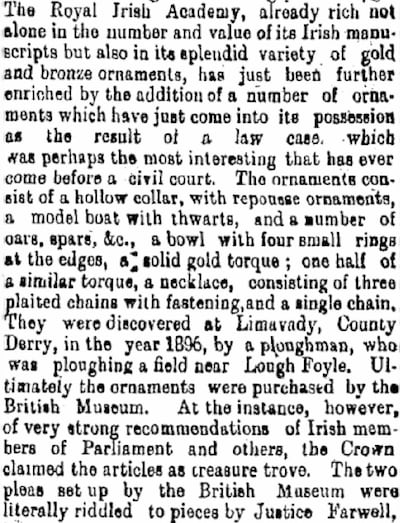Published: August 8th, 1903
In the 1800s, there were occasional stories in The Irish Times about unusual discoveries of gold treasure. On July 9th, 1859, one such story taken from the Limerick Leader appeared in the newspaper. It was about a gold torque purchased by a Mr Wallace, a jeweller in Clonmel. The person selling it "was breaking it up, and applying a portion of it as a ferule for his walking stick, when the glitter of the fold arrested his Gothic hand, and thus the antique piece of national manufacture was saved from destruction".
It's these Irish treasures that inspired some of the Celtic Revival metalwork at the time. On December 20th, 1892, The Irish Times ran a story about a "viceregal inspection", where the Lord Lieutenant visited Edmund Johnson's premises on Grafton Street in Dublin to see "the magnificent collection of Irish antique art metalwork, which he is about [to exhibit] at the World's Fair at Chicago next year". Johnson was the most renowned gold and silversmith in Ireland at the time, and a few years previously had been commissioned to restore the Ardagh Chalice. He was also the creator of the Liam MacCarthy Cup. The Chicago World's Fair became famous for exhibiting the world's first ferris wheel, by George Washington Gale Ferris jnr, and the first moving walkway. The fair ended in tragedy when the mayor of Chicago, Carter Harrison snr, was assassinated.
But it's a story that appeared in the newspaper on August 8th, 1903, that took on a lasting national significance when it comes to Irish treasure. This was a story about a court case, the Royal Irish Academy, and a magnificent hoard of gold.

The Royal Irish Academy, “already rich not alone in the number and value of its Irish manuscripts but also in its splendid variety of gold and bronze ornaments”, the report read, “has just been further enriched by the addition of a number of ornaments which have just come into its possession as the result of a law case which was perhaps the most interesting that has ever come before a civil court”.
The gold in question became known as the Broighter Hoard. It was discovered six years previously by two Derry men, Thomas Nicholl and James Morrow, who were ploughing a field beside Lough Foyle when they made the discovery.
Model boat
“The ornaments consist of a hollow collar . . . a model boat with thwarts, and a number of oars, spars, and a bowl with four small rings at the edges, a solid gold torque, one half of a similar torque, a necklace consisting of three plaited chains with fastening, and a single chain.” Of course the detail that jumps out is that of the model boat, something many Irish people are familiar with. It’s a breathtaking item, its delicateness and sophisticated design appearing both ethereal and contemporary. The boat has been featured on postage stamps and on the commemorative Irish millennium pound. It is a quiet icon.
The hoard has been displayed at the National Museum for more than a century, but the complicated legal wrangling that preceded that is often forgotten. The pieces were initially purchased by the British Museum, but as the report says, Irish members of parliament fought to have the articles claimed as a treasure trove. Two pleas were established by the British Museum, "literally riddled to pieces by Justice Farwell in a speech of great ability", the report said. "The verdict was that the articles were treasure trove, and that accordingly they should be delivered up to the Crown. A few days ago they were handed over to the Royal Irish Academy by the Assistant Under-Secretary for Ireland, and are now on view at the Academy's section in the National Museum, Kildare Street."









